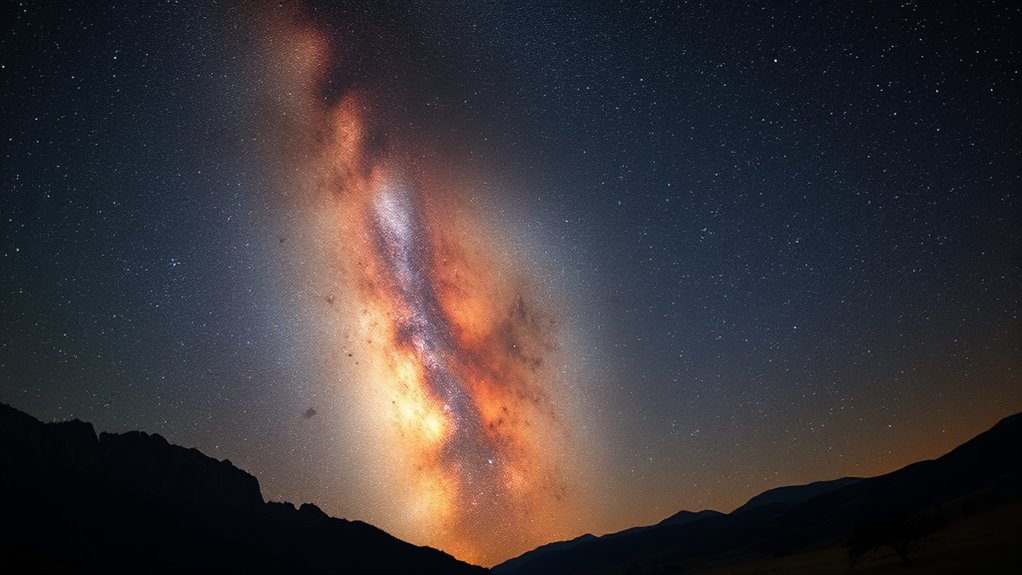If you want to capture stunning Milky Way shots, I recommend exploring the Sony E 16mm F2.8 for its wide coverage, compact size, and bright aperture. The VILTROX 75mm f/1.2 XF PRO is fantastic for detailed, low-light shots, while the AstrHori 6mm fisheye offers unique, immersive perspectives. The VILTROX 75mm f/1.2 PRO E works well for APS-C sensors, and the 78 D Double Aspheric lens excels in clarity and minimal distortion. Keep going to discover how these choices can elevate your night sky photography.
Key Takeaways
- Look for wide-angle lenses (14mm-24mm) with large apertures (f/2 or wider) for expansive night sky coverage and bright star captures.
- Prioritize optical quality with minimal distortion, sharpness, and coatings to ensure clear, vibrant astrophotos.
- Consider lightweight, portable lenses like pancake designs for easier outdoor shooting and quick setup.
- Ensure lens compatibility with your camera mount (Sony E, Fuji X, Nikon Z) for seamless use and optimal performance.
- Durable build quality and additional features like quiet autofocus support versatile, reliable night sky photography.
Sony E 16mm F2.8 Wide-Angle Prime Lens
Are you looking for a compact lens that can capture stunning wide-angle shots of the Milky Way? The Sony E 16mm F2.8 is perfect for this. Its ultra-compact, pancake design makes it easy to carry anywhere, weighing just 67 grams. The 16mm focal length provides a broad field of view, ideal for capturing expansive night skies. With a bright F2.8 aperture, it gathers plenty of light for star photography. Plus, its optical elements minimize distortion and flare, ensuring sharp, vibrant images. Compatible with various converters, it offers versatility without bulk—making it a fantastic choice for astrophotographers on the go.
Best For: astrophotographers and travel enthusiasts seeking a compact, lightweight lens ideal for capturing wide-angle night sky images and expansive landscapes.
Pros:
- Ultra-compact and lightweight design, perfect for portability and travel
- Bright F2.8 aperture allows for excellent low-light and star photography
- Incorporates optical elements to minimize distortion and flare, ensuring sharp, vibrant images
Cons:
- Fixed 16mm focal length limits zoom flexibility
- No image stabilization, which may require a tripod for long exposures
- Compatibility limited to APS-C E-mount cameras, not full-frame systems
VILTROX 75mm f/1.2 XF PRO APS-C Lens for Fuji X-Mount Cameras
The VILTROX 75mm f/1.2 XF PRO APS-C lens stands out as an excellent choice for astrophotographers, especially those shooting with Fuji X-mount cameras. Its large f/1.2 aperture excels in low-light conditions, making it ideal for capturing the Milky Way and starry skies. With 16 elements in 11 groups, including high-refractive lenses, it delivers sharp, detailed images with beautiful bokeh and vibrant colors. The fast, quiet autofocus and manual override provide flexibility for both photography and videography. Its durable metal build and positive user reviews make it a versatile, high-value lens perfect for those looking to elevate their night sky captures.
Best For: astrophotographers and night sky enthusiasts using Fuji X-mount cameras seeking a versatile lens with excellent low-light performance.
Pros:
- Large f/1.2 aperture ideal for capturing starry skies and low-light scenes
- Sharp, detailed images with beautiful bokeh and vibrant colors
- Quiet, fast autofocus with manual override suitable for both photography and videography
Cons:
- Some users report minor chromatic aberration at high contrast scenes
- Plastic parts may feel cheap compared to the metal build, affecting perceived durability
- Slightly heavier weight at 2.82 pounds, which may affect portability for some users
AstrHori 6mm F2.8 Circular Fisheye Lens for Nikon Z Mount
If you’re looking to capture stunning Milky Way shots with an ultra-wide perspective, the AstrHori 6mm F2.8 Circular Fisheye Lens for Nikon Z Mount is an excellent choice. It offers a 220° field of view that exceeds human vision, creating immersive and striking visuals. The large F2.8 aperture guarantees sharp, vibrant images even in low light, perfect for astrophotography. Its all-metal build is durable yet compact, making it travel-friendly. Designed for Nikon Z full-frame mirrorless cameras, it provides manual focus control, allowing for creative flexibility. Whether for artistic storytelling or dynamic landscape shots, this lens opens up new creative possibilities.
Best For: photographers and videographers seeking immersive, artistic fisheye shots, especially in low light or astrophotography scenarios.
Pros:
- 220° ultra-wide perspective creates striking, immersive visuals that surpass human vision.
- Large F2.8 aperture delivers sharp images in challenging lighting conditions, ideal for astrophotography and night scenes.
- Durable all-metal construction combined with compact design makes it travel-friendly and suitable for outdoor use.
Cons:
- Manual focus may require practice for precise adjustments, especially for moving subjects.
- Designed specifically for Nikon Z mount full-frame mirrorless cameras, limiting compatibility with other systems.
- The 220° fisheye effect can be extreme and may not suit all types of photography or preferences.
VILTROX 75mm f/1.2 PRO E Lens for Sony APS-C Cameras
Photographers aiming to capture stunning Milky Way shots will find the VILTROX 75mm f/1.2 PRO E Lens an excellent choice, especially when working with Sony APS-C cameras. Its large f/1.2 aperture allows for exceptional low-light performance, enabling sharp images at high shutter speeds and low ISO. With a robust all-metal build, fast autofocus, and dual aperture control, it’s versatile for both photography and video. Despite some vignetting and weight due to its solid construction, reviews praise its sharpness, clarity, and value. This lens is perfect for astrophotography, portraits, and landscapes, offering creative flexibility at an affordable price point.
Best For: photographers and videographers using Sony APS-C cameras seeking excellent low-light performance, sharp images, and versatile shooting options for astrophotography, portraits, and landscapes.
Pros:
- Exceptional f/1.2 aperture for superior low-light and depth-of-field control
- Sharp, detailed images with high resolution across various shooting conditions
- Durable all-metal construction and fast, quiet autofocus suitable for professional use
Cons:
- Heavier weight due to solid metal build, which may affect portability
- Some vignetting and potential recognition issues with older Sony models
- Large front element requires specialized filters and may be cumbersome for travel
78 D Double Aspheric Lens
Designed with a 78 diopter (D) strength, the D Double Aspheric Lens excels in providing detailed eye assessments, making it an ideal choice for clinicians and researchers requiring precise slit lamp examinations. Its ideal combination of field and magnification allows for clear, detailed views of the eye’s structures. The extended working distance from the cornea improves clinical efficiency and comfort. Despite slight variations due to ongoing research, this lens remains popular, with a solid rating of 4.4 out of 5 stars. Its compact size and lightweight design make it practical for everyday use, ensuring reliable performance for detailed eye evaluations.
Best For: clinicians and researchers seeking precise, detailed eye assessments with an extended working distance during slit lamp examinations.
Pros:
- Offers an optimal combination of field and magnification for detailed eye evaluation
- Provides an extended working distance from the cornea, improving clinical efficiency and comfort
- Compact, lightweight design for ease of use and portability
Cons:
- Product specifications and color may vary slightly due to ongoing R&D
- Limited reviews (9 reviews) may not fully represent long-term durability or performance
- Slightly higher price point compared to basic lenses in the market
Factors to Consider When Choosing Wide-Field Lenses for Milky Way Photography

When selecting a wide-field lens for Milky Way photography, I consider factors like focal length, aperture brightness, and low-light performance to get the best shots. The field of view and size also matter, especially if I want a portable setup. Understanding these points helps me choose a lens that balances image quality and practicality.
Focal Length Range
Choosing the right focal length is essential for capturing stunning Milky Way shots, and it typically falls between 14mm and 35mm. A shorter focal length, like 14mm or 16mm, offers a wider field of view, allowing you to include more of the sky and emphasize the vastness of the Milky Way. These ultra-wide lenses are perfect for dramatic, panoramic shots, but they can introduce some atmospheric distortion. On the other hand, longer focal lengths, such as 24mm or 35mm, provide more zoom, enabling you to focus on specific regions or details within the sky. Your choice depends on whether you want to showcase the entire galaxy or capture intricate features. Consider your scene size, framing preferences, and the level of detail you aim to achieve when selecting your focal length.
Aperture Brightness
A wide aperture is essential for capturing the faint details of the Milky Way in low-light conditions. A lens with an aperture of f/2.8 or brighter (like f/2 or f/1.8) lets in considerably more light, reducing the need for long exposures. This improved brightness enhances the ability to photograph the Milky Way clearly and quickly. Larger apertures also create a shallower depth of field, which helps isolate stars and celestial features from the background, making your images sharper. Additionally, bright lenses enable faster shutter speeds, minimizing star trails caused by Earth’s rotation. Overall, the aperture brightness directly impacts your exposure and image quality, especially in dark sky environments, where every bit of light counts for capturing stunning night sky shots.
Low-Light Performance
Opting for a wide-field lens with a large maximum aperture—like f/1.4 or wider—significantly improves low-light performance in Milky Way photography. This allows more light to reach the sensor, capturing faint stars and details more effectively. A fast lens also enables shorter exposure times, reducing star trails caused by Earth’s rotation. Additionally, good optical design, including aspherical elements, helps maintain sharpness and contrast in dark conditions. Reducing chromatic aberration and flare is vital, as these can obscure subtle celestial features. Lens coatings and proper use of lens hoods help manage flare and ghosting, further enhancing image quality. Overall, choosing a lens optimized for low-light situations ensures brighter, clearer, and more detailed astrophotos.
Field of View
The field of view is a crucial factor when selecting a wide-field lens for Milky Way photography because it determines how much of the night sky you can capture in a single shot. A wider angle, typically between 14mm and 24mm, lets you include more of the Milky Way and surrounding stars, creating stunning compositions. The angle of view, measured in degrees, directly impacts how broad your shot will be — higher degrees mean a larger portion of the sky. However, a wider view can introduce distortion at the edges, affecting star sharpness and accuracy. Finding the right balance is key: you want enough coverage to showcase the sky’s grandeur while maintaining sharpness and minimizing distortion across the frame.
Size and Portability
Size and portability play a significant role when choosing a wide-field lens for Milky Way photography. A compact, lightweight lens like the Sony E 16mm F2.8 makes traveling easier and setup quicker, which is indispensable in outdoor environments. Larger lenses with extensive glass elements tend to be bulkier, offering potentially better image quality but at the cost of portability. Pancake-style lenses, usually less than 23mm long and weighing under 100 grams, provide maximum ease of transport and quick handling. The size of the lens directly affects how comfortably it fits into backpacks or camera bags, impacting your overall mobility during shoots. Selecting a small, portable lens allows for faster setup and greater flexibility, helping you capture stunning night sky shots without hassle.
Autofocus Capability
Autofocus capability in wide-field lenses for Milky Way photography isn’t usually a top priority because manual focusing offers greater precision in low-light conditions. Many astrophotography lenses lack autofocus mechanisms, emphasizing manual control to ensure sharp images in dark skies. When autofocus is available, it needs to be sensitive enough to work reliably in near darkness without hunting or lag, which can ruin a shot. Features like focus peaking can help by providing visual cues for accurate focus when using autofocus. However, relying solely on autofocus in Milky Way photography is tricky due to the low contrast and minimal light. Most astrophotographers prefer manual focus, especially since precise control is essential for capturing crisp, detailed night sky images.
Build Durability
When choosing wide-field lenses for Milky Way photography, durability is essential to guarantee your gear can handle outdoor conditions and accidental impacts. All-metal or reinforced construction ensures the lens can withstand rough handling and harsh environments. Weather-sealed designs keep out dust, moisture, and debris, extending the lens’s lifespan during outdoor shoots. High-quality materials like hardened glass elements and sturdy lens barrels maintain optical clarity and structural integrity over time. Reinforced lens mounts reduce the risk of damage from frequent attachment and detachment, especially in rugged settings. Additionally, shock-resistant features protect the lens from sudden impacts or transportation mishaps, preventing misalignment or internal damage. Prioritizing durability guarantees your equipment remains reliable, even in challenging outdoor conditions.
Compatibility Requirements
Choosing the right wide-field lens for Milky Way photography means making sure it’s compatible with your camera system. First, check that the lens mount matches your camera, like Sony E-mount or Fuji X-mount, to ensure proper fit. Next, confirm the lens is designed for your camera’s sensor size—full-frame or APS-C—to avoid vignetting and crop factor issues. Consider whether the lens supports manual or autofocus, depending on your focusing preference in astrophotography. Also, verify that its minimum focus distance and field of view suit Milky Way shots, allowing you to capture expansive skies. Lastly, think about compatibility with accessories like filters or conversion lenses that can enhance your images. Making sure these factors line up will give you a seamless shooting experience.
Frequently Asked Questions
How Do Lens Aperture Sizes Affect Milky Way Astrophotography?
Aperture sizes directly impact how much light my lens gathers, which is vital for capturing the Milky Way. A wider aperture, like f/2.8 or lower, lets in more light, reducing the exposure time needed and minimizing star trails. I always look for lenses with large apertures because they help me get clearer, brighter shots of the night sky without needing excessive editing or long exposures.
What Is the Best Lens Focal Length for Capturing the Milky Way?
The best focal length for capturing the Milky Way is usually between 14mm and 24mm. Ironically, the wider the lens, the better the shot, because it lets more sky fit into your frame. I prefer around 20mm myself—wide enough to capture the galaxy’s grandeur but not so wide that stars look distorted. It’s all about finding that sweet spot where detail meets a sweeping view.
How Important Is Lens Distortion Correction for Wide-Field Astrophotos?
Lens distortion correction is pretty important for wide-field astrophotos because it helps keep the stars looking sharp and natural. Without it, images can appear warped or bent, especially toward the edges, which can ruin the overall effect. I always make sure to use lenses or software that minimize distortion so my Milky Way shots look as clear and accurate as possible, truly capturing the beauty of the night sky.
Can I Use Crop Sensor Lenses for Wide-Field Milky Way Shots?
Using crop sensor lenses for Milky Way shots is like trying to paint a vast mural with a small brush; it can work, but you’ll miss some of the grandeur. Crop sensor lenses are generally smaller and have a narrower field of view, so you might need to crop or stitch images. For the best wide-angle perspective, full-frame lenses are ideal, but crop sensors can still produce impressive results with proper technique.
What Are the Advantages of Fisheye Lenses for Night Sky Photography?
Fisheye lenses are fantastic for night sky photography because they capture a super wide field of view, making the sky look dramatic and immersive. They’re perfect for showcasing the Milky Way’s grandeur and the star trails’ circular patterns. Plus, their unique distortion adds an artistic touch, giving your shots a creative edge. I love using them to make my night sky images feel expansive and dynamic.
Conclusion
Choosing the right wide-field lens is like finding the perfect window to the universe. Each lens offers a unique view of the stars, from sweeping panoramas to intricate details. When you pick one, you’re not just selecting gear—you’re opening a portal to endless wonder. So, gear up, point your camera skyward, and let your lens capture the infinite beauty of the Milky Way. Your journey to the stars starts now.















